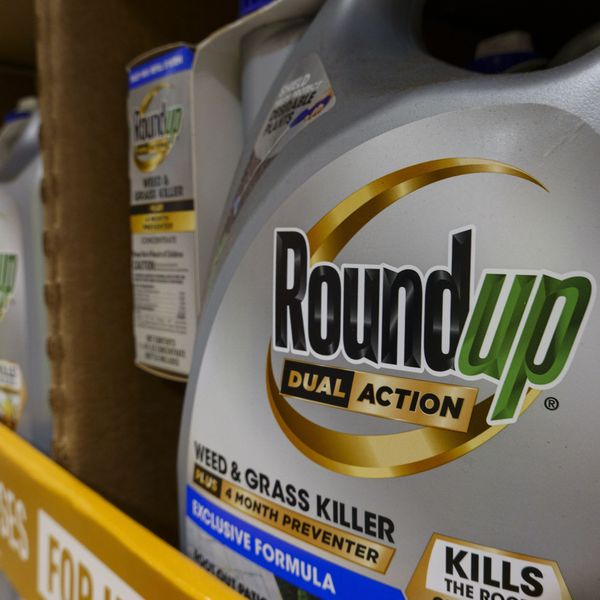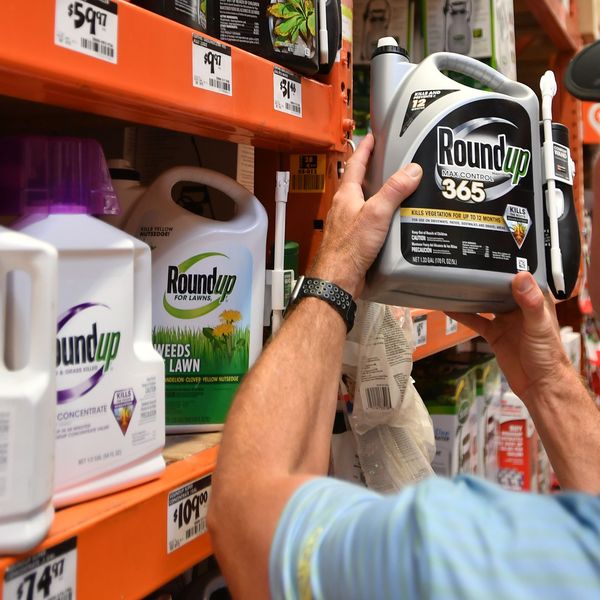
Atrazine is mostly used on corn, according to Civil Eats, "but also on sorghum, sugarcane, and a few other crops, as well as on golf courses, Christmas tree farms, and in residential landscaping." (Photo: TumblingRun/flickr/cc)
Trump EPA Denounced for 'Disgusting' Decision on Atrazine, Herbicide Tied to Birth Defects
One critic warned that "this decision imperils the health of our children and the safety of drinking water supplies across much of the nation."
The Trump administration alarmed environmental and public health advocates on Friday with the Environmental Protection Agency's decision to reauthorize the use of atrazine, an herbicide common in the United States but banned or being phased out in dozens of countries due to concerns about risks such as birth defects and cancer.
"Use of this extremely dangerous pesticide should be banned, not expanded."
--Nathan Donley, CBD
"Use of this extremely dangerous pesticide should be banned, not expanded," declared Nathan Donley, a senior scientist at the Center for Biological Diversity (CBD). "This disgusting decision directly endangers the health of millions of Americans."
"This decision imperils the health of our children and the safety of drinking water supplies across much of the nation," Donley added. "No one will be left untouched by the bad decision the EPA just made."
\u201cA little known fact is that atrazine is one of the many dangerous pesticides allowed on national wildlife refuges \u2014 places that are supposed to protect endangered wildlife and plants. It's also the most commonly detected pesticide in tap water. https://t.co/kH9pZsfMuM\u201d— Center for Biological Diversity (@Center for Biological Diversity) 1600209602
While EPA Administrator Andrew Wheeler called the final interim decision "another example of the Trump administration taking action in support of America's farmers," critics called out the agency for discarding precautions mandated under the Food Quality Protection Act and ignoring epidemiological research.
As a statement from CBD detailed Friday:
The EPA also reduced the protection factor it uses to convert toxicity levels observed in rat and mouse studies to levels considered safe for humans. The more permissive benchmark relies solely on a model developed by the primary manufacturer of atrazine, Syngenta.
Had the correct standards been used, atrazine uses on lawns and turf would likely have been cancelled due to unacceptable harms to children. In today's decision the agency is only proposing a modest reduction in application rate for turf.
The reapproval also weakens environmental safeguards put in place in 2006 to protect aquatic life from harmful atrazine exposure, a move that will increase the amount of atrazine allowed in waterways across the United States.
Reporting last year on the administration's plans to weaken regulations on the herbicide, Civil Eats explained that "atrazine is banned in Europe, due to its potential to contaminate water sources, but widely used in the U.S., where about 70 million pounds of the pesticide is sprayed."
Atrazine is mostly used on corn, the outlet pointed out, "but also on sorghum, sugarcane, and a few other crops, as well as on golf courses, Christmas tree farms, and in residential landscaping. Runoff washes the chemical into streams, rivers, and groundwater; it's one of the most common pollutants found in American waters."
"Independent research has shown atrazine's impact on aquatic life is significant: it can lead to reduced survival, growth, immunity, and sensory capacities, increased disease, as well as reproductive and developmental abnormalities, and behavioral changes," Civil Eats added. "There's also evidence the herbicide harms plants and wildlife. In humans, it's associated with thyroid, ovarian, and other cancers, low birth outcomes, pre-term delivery, and birth defects."
"Rather than heed the huge body of independent science demonstrating these harms, and banning this toxic pesticide, the Trump EPA apparently allowed atrazine manufacturers to call the shots."
--Bill Freese, Center for Food Safety
Noting the impacts on aquatic plants, fish, amphibians, and humans, Bill Freese, science policy analyst at the Center for Food Safety, said in a statement Friday that "this misguided approval of atrazine--so clearly undertaken for political reasons--flies in the face of massive evidence of its environmental and human health harms."
"Rather than heed the huge body of independent science demonstrating these harms, and banning this toxic pesticide," said Freese, "the Trump EPA apparently allowed atrazine manufacturers to call the shots."
Sylvia Wu, senior attorney at the Center for Food Safety, put the decision in a broader context, saying that it "continues an unlawful pattern by the Trump administration of approving toxic pesticides without rigorously analyzing or accounting for their harmful effects."
"EPA admits that atrazine is harmful to multiple species," Wu noted. "Under federal pesticide law, EPA is required to review and ensure that older pesticides do not harm humans or cause unreasonable adverse effects to the environment. Rather than meeting that obligation, EPA has allowed atrazine use to continue by relying on weak mitigation measures and voluntary industry programs."
"The Ninth Circuit Court of Appeals recently held that EPA cannot rely on unworkable mitigation measures when it vacated EPA's decision to register the pesticide dicamba," she added. "It is unfortunate that the agency has not learned its lesson."
An Urgent Message From Our Co-Founder
Dear Common Dreams reader, The U.S. is on a fast track to authoritarianism like nothing I've ever seen. Meanwhile, corporate news outlets are utterly capitulating to Trump, twisting their coverage to avoid drawing his ire while lining up to stuff cash in his pockets. That's why I believe that Common Dreams is doing the best and most consequential reporting that we've ever done. Our small but mighty team is a progressive reporting powerhouse, covering the news every day that the corporate media never will. Our mission has always been simple: To inform. To inspire. And to ignite change for the common good. Now here's the key piece that I want all our readers to understand: None of this would be possible without your financial support. That's not just some fundraising cliche. It's the absolute and literal truth. We don't accept corporate advertising and never will. We don't have a paywall because we don't think people should be blocked from critical news based on their ability to pay. Everything we do is funded by the donations of readers like you. Will you donate now to help power the nonprofit, independent reporting of Common Dreams? Thank you for being a vital member of our community. Together, we can keep independent journalism alive when it’s needed most. - Craig Brown, Co-founder |
The Trump administration alarmed environmental and public health advocates on Friday with the Environmental Protection Agency's decision to reauthorize the use of atrazine, an herbicide common in the United States but banned or being phased out in dozens of countries due to concerns about risks such as birth defects and cancer.
"Use of this extremely dangerous pesticide should be banned, not expanded."
--Nathan Donley, CBD
"Use of this extremely dangerous pesticide should be banned, not expanded," declared Nathan Donley, a senior scientist at the Center for Biological Diversity (CBD). "This disgusting decision directly endangers the health of millions of Americans."
"This decision imperils the health of our children and the safety of drinking water supplies across much of the nation," Donley added. "No one will be left untouched by the bad decision the EPA just made."
\u201cA little known fact is that atrazine is one of the many dangerous pesticides allowed on national wildlife refuges \u2014 places that are supposed to protect endangered wildlife and plants. It's also the most commonly detected pesticide in tap water. https://t.co/kH9pZsfMuM\u201d— Center for Biological Diversity (@Center for Biological Diversity) 1600209602
While EPA Administrator Andrew Wheeler called the final interim decision "another example of the Trump administration taking action in support of America's farmers," critics called out the agency for discarding precautions mandated under the Food Quality Protection Act and ignoring epidemiological research.
As a statement from CBD detailed Friday:
The EPA also reduced the protection factor it uses to convert toxicity levels observed in rat and mouse studies to levels considered safe for humans. The more permissive benchmark relies solely on a model developed by the primary manufacturer of atrazine, Syngenta.
Had the correct standards been used, atrazine uses on lawns and turf would likely have been cancelled due to unacceptable harms to children. In today's decision the agency is only proposing a modest reduction in application rate for turf.
The reapproval also weakens environmental safeguards put in place in 2006 to protect aquatic life from harmful atrazine exposure, a move that will increase the amount of atrazine allowed in waterways across the United States.
Reporting last year on the administration's plans to weaken regulations on the herbicide, Civil Eats explained that "atrazine is banned in Europe, due to its potential to contaminate water sources, but widely used in the U.S., where about 70 million pounds of the pesticide is sprayed."
Atrazine is mostly used on corn, the outlet pointed out, "but also on sorghum, sugarcane, and a few other crops, as well as on golf courses, Christmas tree farms, and in residential landscaping. Runoff washes the chemical into streams, rivers, and groundwater; it's one of the most common pollutants found in American waters."
"Independent research has shown atrazine's impact on aquatic life is significant: it can lead to reduced survival, growth, immunity, and sensory capacities, increased disease, as well as reproductive and developmental abnormalities, and behavioral changes," Civil Eats added. "There's also evidence the herbicide harms plants and wildlife. In humans, it's associated with thyroid, ovarian, and other cancers, low birth outcomes, pre-term delivery, and birth defects."
"Rather than heed the huge body of independent science demonstrating these harms, and banning this toxic pesticide, the Trump EPA apparently allowed atrazine manufacturers to call the shots."
--Bill Freese, Center for Food Safety
Noting the impacts on aquatic plants, fish, amphibians, and humans, Bill Freese, science policy analyst at the Center for Food Safety, said in a statement Friday that "this misguided approval of atrazine--so clearly undertaken for political reasons--flies in the face of massive evidence of its environmental and human health harms."
"Rather than heed the huge body of independent science demonstrating these harms, and banning this toxic pesticide," said Freese, "the Trump EPA apparently allowed atrazine manufacturers to call the shots."
Sylvia Wu, senior attorney at the Center for Food Safety, put the decision in a broader context, saying that it "continues an unlawful pattern by the Trump administration of approving toxic pesticides without rigorously analyzing or accounting for their harmful effects."
"EPA admits that atrazine is harmful to multiple species," Wu noted. "Under federal pesticide law, EPA is required to review and ensure that older pesticides do not harm humans or cause unreasonable adverse effects to the environment. Rather than meeting that obligation, EPA has allowed atrazine use to continue by relying on weak mitigation measures and voluntary industry programs."
"The Ninth Circuit Court of Appeals recently held that EPA cannot rely on unworkable mitigation measures when it vacated EPA's decision to register the pesticide dicamba," she added. "It is unfortunate that the agency has not learned its lesson."
- Low-Paid Immigrant Farmworkers Most at Risk From Toxic Weedkiller US Refuses to Ban ›
- EPA Takes 'Historic' Step to Halt Dangerous Herbicide Use | Common Dreams ›
- Opinion | Toxic Trump Was Not Good for Your Health | Common Dreams ›
- Trump EPA 'Hitting New Heights of Absurdity' With Plan to Reapprove Pesticide Dicamba | Common Dreams ›
- 'Absolute Joke': Big Ag Lobby Wins Again as Trump Admin 'Doubles Down' on Atrazine | Common Dreams ›
- A Month After Trump Doubles Down on Atrazine, WHO Dubs It 'Probably Carcinogenic to Humans' | Common Dreams ›
The Trump administration alarmed environmental and public health advocates on Friday with the Environmental Protection Agency's decision to reauthorize the use of atrazine, an herbicide common in the United States but banned or being phased out in dozens of countries due to concerns about risks such as birth defects and cancer.
"Use of this extremely dangerous pesticide should be banned, not expanded."
--Nathan Donley, CBD
"Use of this extremely dangerous pesticide should be banned, not expanded," declared Nathan Donley, a senior scientist at the Center for Biological Diversity (CBD). "This disgusting decision directly endangers the health of millions of Americans."
"This decision imperils the health of our children and the safety of drinking water supplies across much of the nation," Donley added. "No one will be left untouched by the bad decision the EPA just made."
\u201cA little known fact is that atrazine is one of the many dangerous pesticides allowed on national wildlife refuges \u2014 places that are supposed to protect endangered wildlife and plants. It's also the most commonly detected pesticide in tap water. https://t.co/kH9pZsfMuM\u201d— Center for Biological Diversity (@Center for Biological Diversity) 1600209602
While EPA Administrator Andrew Wheeler called the final interim decision "another example of the Trump administration taking action in support of America's farmers," critics called out the agency for discarding precautions mandated under the Food Quality Protection Act and ignoring epidemiological research.
As a statement from CBD detailed Friday:
The EPA also reduced the protection factor it uses to convert toxicity levels observed in rat and mouse studies to levels considered safe for humans. The more permissive benchmark relies solely on a model developed by the primary manufacturer of atrazine, Syngenta.
Had the correct standards been used, atrazine uses on lawns and turf would likely have been cancelled due to unacceptable harms to children. In today's decision the agency is only proposing a modest reduction in application rate for turf.
The reapproval also weakens environmental safeguards put in place in 2006 to protect aquatic life from harmful atrazine exposure, a move that will increase the amount of atrazine allowed in waterways across the United States.
Reporting last year on the administration's plans to weaken regulations on the herbicide, Civil Eats explained that "atrazine is banned in Europe, due to its potential to contaminate water sources, but widely used in the U.S., where about 70 million pounds of the pesticide is sprayed."
Atrazine is mostly used on corn, the outlet pointed out, "but also on sorghum, sugarcane, and a few other crops, as well as on golf courses, Christmas tree farms, and in residential landscaping. Runoff washes the chemical into streams, rivers, and groundwater; it's one of the most common pollutants found in American waters."
"Independent research has shown atrazine's impact on aquatic life is significant: it can lead to reduced survival, growth, immunity, and sensory capacities, increased disease, as well as reproductive and developmental abnormalities, and behavioral changes," Civil Eats added. "There's also evidence the herbicide harms plants and wildlife. In humans, it's associated with thyroid, ovarian, and other cancers, low birth outcomes, pre-term delivery, and birth defects."
"Rather than heed the huge body of independent science demonstrating these harms, and banning this toxic pesticide, the Trump EPA apparently allowed atrazine manufacturers to call the shots."
--Bill Freese, Center for Food Safety
Noting the impacts on aquatic plants, fish, amphibians, and humans, Bill Freese, science policy analyst at the Center for Food Safety, said in a statement Friday that "this misguided approval of atrazine--so clearly undertaken for political reasons--flies in the face of massive evidence of its environmental and human health harms."
"Rather than heed the huge body of independent science demonstrating these harms, and banning this toxic pesticide," said Freese, "the Trump EPA apparently allowed atrazine manufacturers to call the shots."
Sylvia Wu, senior attorney at the Center for Food Safety, put the decision in a broader context, saying that it "continues an unlawful pattern by the Trump administration of approving toxic pesticides without rigorously analyzing or accounting for their harmful effects."
"EPA admits that atrazine is harmful to multiple species," Wu noted. "Under federal pesticide law, EPA is required to review and ensure that older pesticides do not harm humans or cause unreasonable adverse effects to the environment. Rather than meeting that obligation, EPA has allowed atrazine use to continue by relying on weak mitigation measures and voluntary industry programs."
"The Ninth Circuit Court of Appeals recently held that EPA cannot rely on unworkable mitigation measures when it vacated EPA's decision to register the pesticide dicamba," she added. "It is unfortunate that the agency has not learned its lesson."
- Low-Paid Immigrant Farmworkers Most at Risk From Toxic Weedkiller US Refuses to Ban ›
- EPA Takes 'Historic' Step to Halt Dangerous Herbicide Use | Common Dreams ›
- Opinion | Toxic Trump Was Not Good for Your Health | Common Dreams ›
- Trump EPA 'Hitting New Heights of Absurdity' With Plan to Reapprove Pesticide Dicamba | Common Dreams ›
- 'Absolute Joke': Big Ag Lobby Wins Again as Trump Admin 'Doubles Down' on Atrazine | Common Dreams ›
- A Month After Trump Doubles Down on Atrazine, WHO Dubs It 'Probably Carcinogenic to Humans' | Common Dreams ›

